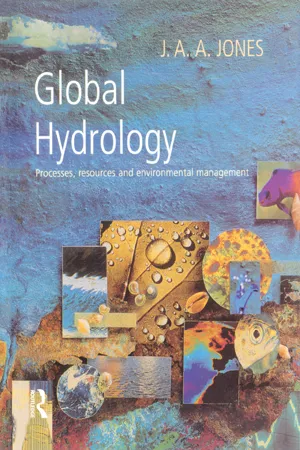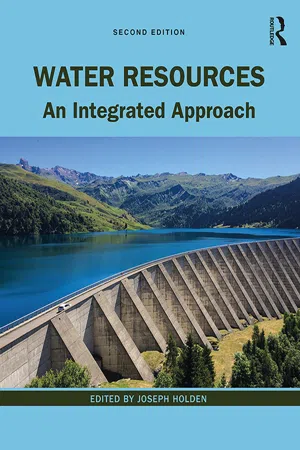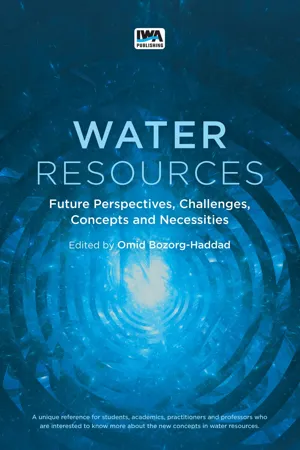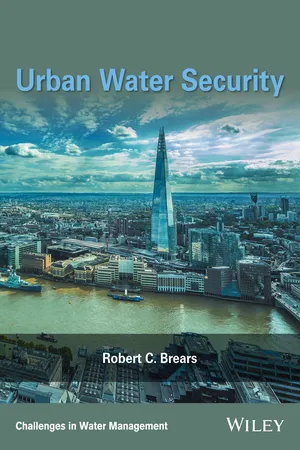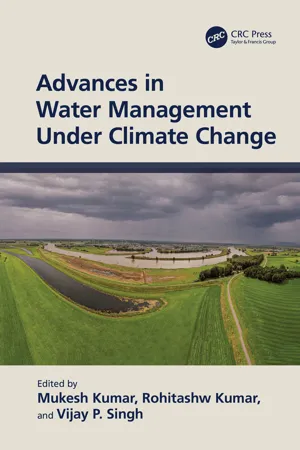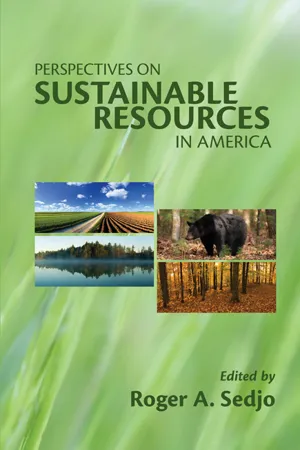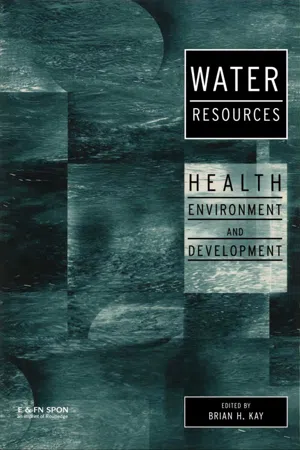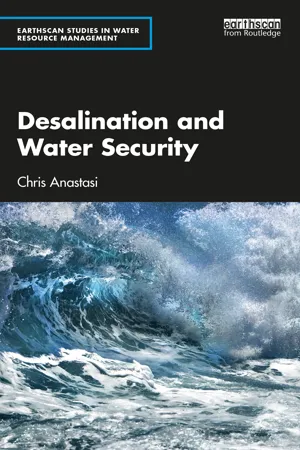Geography
Sustainable Water
Sustainable water refers to the responsible management and use of water resources to meet current needs without compromising the ability of future generations to meet their own needs. This involves ensuring access to clean water, minimizing pollution, and promoting efficient water use through conservation and recycling. Sustainable water practices are essential for environmental preservation and human well-being.
Written by Perlego with AI-assistance
Related key terms
12 Key excerpts on "Sustainable Water"
- eBook - ePub
Global Hydrology
Processes, Resources and Environmental Management
- J. A. A. Jones(Author)
- 2014(Publication Date)
- Routledge(Publisher)
CHAPTER 11 Towards a sustainable future?Topics covered11.1 Desalination – a source of ‘new’ water? 11.2 Controlling demand and waste 11.3 Protecting the environment 11.4 Hydropolitics 11.5 The threat of global warming 11.6 Integrated water resource managementThe ultimate aim of water management must be sustainable consumption. The need for sustainability advocated by Lvovich in 1970 is even clearer now that some parts of the world are approaching the limits of exploitation, and the impacts of unrestrained development on water quality and the environment are so obvious. Agenda 21 of the UN Conference on Environment and Development in Rio in 1992 specified the need to protect the quality and supply of freshwater resources by an integrated approach to the development, management and use of water in a sustainable way.In a report that laid many of the foundations for the new perception of a sustainable future, the UN World Commission on Environment and Development (1987) defined a sustainable society as one that satisfies its needs without compromising the ability of future generations to meet theirs. According to the textbook definition of Camp (1994) a sustainable world ‘means that human activity would not degrade the planet’s carrying capacity forever for other humans’. More simply, it is a matter of living within our resources.For water resources, sustainability may be defined at three different levels: (1) the narrow viewpoint of maintaining the physical water resources; (2) the broader aim of maintaining basin ecosystems; or (3) the all-encompassing aim of sustaining a balance between social and physical components, between economic returns, social equity, and ecological and hydrological needs (Dixon and Fallon 1989). Adopting the latter goal, Sustainable Water resource management is defined for UNESCO as ‘a set of activities that ensures that the value of the services provided by a given water resource system will satisfy present objectives of society without compromising the ability of the system to satisfy the objectives of future generations’ (Hufschmidt and Tejwani 1993). ‘Services’ are here taken to include the protection of ecosystems. - eBook - ePub
Water Resources
An Integrated Approach
- Joseph Holden, Joseph Holden(Authors)
- 2019(Publication Date)
- Routledge(Publisher)
Here we refer to sustainability in the sense of meeting the needs of the present without compromising the ability of future generations to meet their own needs. To achieve sustainability requires people from different backgrounds and disciplines to work together. Abstracting groundwater that is ancient, and non-renewable in the short term, is not sustainable (Chapter 5). This is why most assessments of available freshwater resources for countries or per person per year are based on ‘renewable’ freshwater resources (Chapter 1). Managing and forecasting water demand is clearly an important approach to sustainability. This requires scientists and engineers who understand water-cycle processes to work with climate change modellers and with those who work on population dynamics, migration, land use, cropping systems and so on in order that the science base is best prepared for the challenges ahead and so that the policy community can be best informed. Chapter 9 outlined several strategies for demand management, noting that a focus on innovation in the agricultural sector was crucial for global water resources because that is where most consumptive water use takes place. Food waste and overconsumption of water will have to be reduced. The world is interconnected and trade means that, even if you live in an area that has abundant water, you might be contributing to water scarcity for other people in different parts of the world through your use of products from those water-scarce areas - Omid Borzog-Haddad(Author)
- 2021(Publication Date)
- IWA Publishing(Publisher)
Sustainability of water management in urban, agricultural and environmental contexts is essential for sustainable development. There are many ways to evaluate sustainable management practices. Integrating socio-economic characteristics of environmental systems should be quantified in order to represent and implement developments. Urban water management in developing regions faces challenges such as unequal distribution of water due to rapid population growth. Sustainable management plans should focus on issues such as attracting shareholders to invest in developing areas and revitalizing and reusing water in developed areas. Water reuse reduces the stresses caused by drought periods. However, there are still obstacles, including the cost of using these technologies and the risks involved in developing and developed countries alike. Improving water productivity in the agricultural sector is beneficial to all other sectors through the use of new irrigation technologies and methods, as it reduces competition between agricultural, urban and environmental sectors. Achieving water sustainability only in the environmental field could be inconsistent with other development plans, and occur as a result of a restricted and uncomprehensive approach. However, long-term economic development and social goals of societies are linked to both environmental health and environmental fracture, which is why developed countries emphasize socio-economic development. Sustainable Water management can provide sustainability in all socioeconomic and environmental sectors in areas with diverse geographies.Sustainability indices (SIs) such as reliability, resiliency, and vulnerability are indices that determine the probability of successful water allocation, probability of a system returning to its desired state after a failure, and the magnitude of damage that system receives during failures, respectively. Various types of studies in the field of Sustainable Water resources management have been carried out and have unveiled the advantages of sustainable development management of these human-natural systems. Furthermore, sustainability in the field of water management can be applied to different types of water bodies; such as sustainable groundwater management, sustainable river basins, coastal basins, and to other kinds of water bodies. Current research has introduced a wide range of applications of Sustainable Water resources research, not only making systems more sustainable but also reducing vulnerabilities in the future.There are different ways to apply sustainability in water resources management. One practical way to model Sustainable Water management is a multi-criteria decision-making process that provides higher efficiency in water allocation. Another way is the risk reduction approach in water supply, environmental protection, and economic efficiency, which ensures long-term and flexible water supply in agricultural, municipal, and industrial sectors. In addition to reliability, resiliency and vulnerability, the Water Poverty Index (WPI) summarizes the information required to evaluate the sustainability of water systems and can be used as a singular measure to assist decision-makers in determining priorities and coming up with proper development plans.- eBook - ePub
- David E. McNabb(Author)
- 2019(Publication Date)
- Palgrave Macmillan(Publisher)
sustainability needs.In their efforts to achieve Sustainable Water supply resources and systems, water-system managers are adopting new and innovative water and wastewater management practices and procedures (Lall et al. 2008 ; Cohen 2011 ). This chapter examines the some of the many ways that water suppliers are working to achieve and maintain a sustainable supply of clean, safe and affordable water.- 1. Developing and implementing long-term policies for ensuring the sustainable supply and distribution of services.
- 2. Adopting new and innovative water source governance and management models.
- 3. Seeking and adopting open and cooperative innovation.
- 4. Adapting to new and innovative sustainability goals.
- 5. Mandating water conservation practices.
- 6. Securing alternative water resources.
- 7. Applying asset management practices to ensure a resilient water infrastructure.
Box 3.1 Combination of forces threatening the global water supply
The combined effects of continued global pullulation growth, urbanization, pollution, and climate change are contributing to a rapidly approaching global water problem. “Feeding 9 billion people by 2050 will require a 60 percent increase in agricultural production (which in 2017 used 70 percent of the available resource), and a 15 percent increase in water withdrawals. Besides this increasing demand, the resource is already scarce in many parts of the world. Estimates indicate that 40 percent of the world population live in water scarce areas… By 2025, about 1.8 billion people will be living in regions or countries with absolute water scarcity. Water security is a major—and often growing—challenge for many countries today.The fragmentation of (the world’s water) resource also constrains water security. There are 276 transboundary basins, shared by 148 countries, which account for 60% of the global freshwater flow. Similarly, 300 aquifers systems are transboundary in nature, meaning 2 billion people worldwide are dependent on groundwater. The challenges of fragmentation are often replicated at the national scale, meaning cooperation is needed to achieve optimal water resources management and development solutions for all riparians. - eBook - ePub
People and Environment
A Global Approach
- Gareth Jones(Author)
- 2014(Publication Date)
- Routledge(Publisher)
By comparison, the implications of the current challenge to provide a sustainable, safe water supply is several magnitudes greater and is of concern to approximately two-thirds of the world population – some four billion people living in almost every part of the world. The meeting of the World Water Forum held at The Hague in March 2000 and the eleventh Water Symposium held in Stockholm in August 2001 (http://www.siwi.org/menu/valframe.asp) recognised the numerous fundamental goal conflicts that exist in global water management issues and concluded that despite the fundamental necessity of water, provision of water had a relatively low priority for many government bodies. Politicians focus on the visible and acute water management crises rather than the invisible, slow changes that in the long run may undermine the structure of society. These are strong claims and this chapter investigates some of the main problems concerning water management and, where possible, suggests long-term, sustainable solutions. 5.2 The uniqueness of water (hydrological cycle) It is impossible to study fresh water resources without first making a brief reference to the salt water oceans. Fresh water is derived from the oceans and, once used, returns to the oceans as part of the great hydrological cycle (see Figure 5.1). Water is the one commodity that makes our planet different, perhaps unique, from all the others in our galaxy. Water covers approximately 70 per cent of the surface of the planet and at its deepest point, in the Mariana Trench east of the Philippines, reaches a depth of 10,924 metres. The potential usefulness of water as a human living space is severely limited by three factors: the intense pressure below ten metres of the surface; the lack of sunlight below about 30 metres and the saltiness of the oceans. As a consequence of these physical and chemical restrictions, the oceans have been seen as a negative human resource - eBook - ePub
- Robert C. Brears(Author)
- 2017(Publication Date)
- Wiley(Publisher)
Freshwater resources can be considered renewable if carefully managed; however, they can be considered non-renewable and unsustainable if they are overexploited or ‘mined’ (rc/rs > 1). Meanwhile, water use can be considered sustainable if the resource is utilised at a rate in which supply is greater than the amount consumed (rc/rs < 1). With increases in climate change-induced drought and scarcity, along with increases in population, it is common for consumption to be greater than supply (rc > rs), and therefore unsustainable, in many parts of the world. 65 The most appropriate form of sustainability in urban water management is the strong sustainability viewpoint for three reasons: first, strong sustainability ensures current and future generations can meet their basic water needs; second, strong sustainability ensures there is sufficient water to produce goods and services; and third, strong sustainability ensures there is adequate quality and quantity of water resources necessary to protect ecosystems. 66 Therefore, strong sustainability reduces the potential for conflicts and tensions between the environmental, economic and social pillars of sustainable development. 67, 68, 69, 70 3.2.1 Environmental pillar in strong sustainable urban water management In strong sustainability the environmental pillar of sustainable urban water management aims to protect the quality and quantity of water necessary for the survival of both humans and nature. 71, 72 In particular, the environmental pillar recognises the need to protect the numerous services provided by ecosystems that are beneficial to humans and nature: Provisioning services : Services focused on directly supplying food and non-food products from water flows (freshwater supplies, crop production, hydropower, timber, livestock, - Mukesh Kumar, Rohitashw Kumar, Vijay P. Singh, Mukesh Kumar, Rohitashw Kumar, Vijay P. Singh(Authors)
- 2023(Publication Date)
- CRC Press(Publisher)
1 Water Resource Management An Approach to Sustainable Water Management Ananya Mishra and Rohitashw KumarDOI: 10.1201/9781003351672-11.1 INTRODUCTION
Water is the most important and sustainable natural reserve, which is in serious distress due to its increasing demand though supply decreases. The requirement and demand for water have increased dramatically in cities as a result of increased industrialization, globalization, urban growth, and other such phenomena, which has been exacerbated by the increased population water demand resulting in various types of wastes and sewerages water. Governments and scientists have recognized the value of maximizing of various resource use while minimizing waste and losses. The available water resources in saline oceans contain 97 per cent of the world's water. Two-thirds of the remaining 3 per cent have deposited as ice masses in the polar region and in the form of ice in the mountains. As a corollary, fresh running water accounts for 1 per cent of the Earth's water, of which 98 per cent is groundwater (Jafari et al., 2018a). In a global sense, India's water supply outlook owns just 4 per cent of the world's water supplies while housing 16 per cent of the global population, meaning India's per capita water available is very limited. The amount of accessible water here is approximately 6 trillion m3 , which is the world's highest for a nation of equivalent extent (Jafari et al., 2018a). Water exists in the oceans, atmosphere, between the soil, and fragments of the Earth crust. Renewable radiation drives the movement of water as it transmits between the lithosphere and the environment via evaporation and precipitation. However, owing to wastage and inadequate water conservation schemes, as well as uneven rainfall distribution, a significant portion of the world suffers from water shortages during the year's dry period (Mushtaq et al., 2020). For the past three decades, there has been an increase in water erosion. Not only has the rate and severity of water erosion increased but also the area of water erosion areas, and as a result of increased flooding. In about an area of 125 million hectares of watersheds (62 per cent of the total country), water erosion has been higher than the natural rate, and sedimentation has also increased (Jafari et al.- eBook - ePub
- Donald Siegel(Author)
- 2016(Publication Date)
- WSPC(Publisher)
During the 20th century sharp growth in human population and industry swelled demand for potable water 1 placing infrastructures under severe strain (Economy & Lieberthal, 2007). On the other hand, both fluvial and pluvial flooding 2 is an increasing problem in many places due to land use modifications associated with urbanization and vegetated flood plains becoming impermeable surfaces resulting in faster discharge of stormwater 3 into river channels (Goonetillekea et al., 2005). Challenges over the effective management of water resource have been further exacerbated by climate change, pressuring current management practices (IPCC, 2014) to more effectively deal with water risks. Recognizing increasing strains on water resources and the ongoing need to maintain ecological integrity, society has begun to realize that the supply of potable water is not endless and requires more careful management (Kurland & Zell, 2009). Sustainable Water management has risen in prominence as an alternative, seeking to deliver benefits beyond conventional management approaches for current and future generations. Sustainable Water management is difficult to define but is essentially an integrated approach to water supply, stormwater management and sewerage to avoid wasting useful resources (nutrients, energy, and water) and enhance social and ecological benefits (Kennedy et al., 2007; Marlow et al., 2013). However, one size organizational approach does not fit all water sources. For example, some places like California, Perth and Sao Paulo suffer from insufficient water (drought) while others such as Shanghai, Delhi and Bangkok commonly suffer from too much water (flooding). Despite its importance, the organization and management literature has largely ignored the topic of water resources, particularly in the top journals (Kurland & Zell, 2010; Whiteman et al., 2013) - eBook - ePub
- Roger A. Professor Sedjo, Roger A. Professor Sedjo(Authors)
- 2010(Publication Date)
- Routledge(Publisher)
The focus on restoration of historic flow patterns is widely accepted as a way to manage rivers in the future (NRC 1992, 1999a, 2002b, 2004b, 2007a; Stanford et al. 1996;Van Herick 2000; Koel and Sparks 2002).That flow as well as flow variability is a fundamental premise of Sustainable Water management is illustrated by how the term sustainability is applied to groundwater pumping. In the conservation tradition, the amount of water pumped from aquifer storage was supposed to be restricted to long-term aquifer recharge. Definitions of sustainable groundwater use recognize the link between aquifer pumping and surface water conditions. Sustainable groundwater use means restricting pumping to minimize the adverse effects on surface water in rivers, streams, and lakes hydrologically connected to the aquifer (Sophocleous 2000; Alley and Leake 2004;Alley 2006).Ecologically Sustainable Water management seeks to secure the “ecological health” or “integrity” of watersheds, terms that have been incorporated into the language used by federal and state agencies. However, if integrity and health define sustainable surface water and groundwater management, then the terms will need operational definition (Holland 2000; Lackey 2001). Many definitions of integrity and health are based on a reference condition that “approximates natural, un-impacted conditions for a waterbody. Since undisturbed or minimally disturbed conditions may be difficult or impossible to find, least disturbed conditions, combined with historical information, models or other methods may be used to approximate reference condition as long as the departure from natural or ideal is understood” (U.S. EPA 2007a).By this definition, the predisturbance hydrograph is one possible definition for river integrity or health, even though historical flow regimes cannot be achieved if other water uses are also going to be met. In fact, the consequences of river modification are not always detrimental.“Water management for human uses necessarily alters a river's natural flow regime in various ways.” However, Richter et al. (2003, 207 - eBook - ePub
Water Resources
Health, Environment and Development
- Brian Kay(Author)
- 1998(Publication Date)
- CRC Press(Publisher)
Chapter 4Water resources development: policy perspectives of the Food and Agricultural Organization in relation to food security
Arumugam Kandiah
4.1 Introduction
Water sustains life; it is indispensable for the welfare of human beings and their natural environment. But scarcity and misuse of this life-supporting resource pose a serious and growing threat to food security, human health and well-being, industrial development and the ecosystems on which they depend. Scarcity or poor quality can have a dramatic impact not only on agricultural production, but on all aspects of everyday life, very often adding to the burden of women. There is an urgent need for judicious management of water resources worldwide.The world has witnessed the benefits and disadvantages of, respectively, the wise use and misuse of water as well as the hazards posed to natural resources, human health and environment by improper water resources developments based on inappropriate water policies. The Food and Agriculture Organization (FAO) believes that in order to overcome current deficiencies and to meet the total water needs of the human population, the management of water resources must form part of the spectrum of development endeavour. This approach offers the prospect of sustainable use of available water supplies as well as cost-effective solutions to present-day water problems. A wider understanding among different users, where each attaches a different value to it, that misuse by one group can adversely affect the others would be a major step towards achieving effective water management and harmony.4.2 The hydrological cycle
Fresh water is a renewable resource by virtue of the hydrological cycle, but for all practical purposes it is a finite one. The hydrological cycle is a continuous process by which water is transported from the oceans to the atmosphere to the land and back to the sea. Every year solar energy converts 500,000 km3 of water from sea and land into water vapour, which eventually returns to the earth’s surface as rain and snow (Figure 4.1 - eBook - ePub
Chemistry and Water
The Science Behind Sustaining the World's Most Crucial Resource
- Satinder Ahuja(Author)
- 2016(Publication Date)
- Elsevier(Publisher)
Chapter OneOverview
Sustaining Water, the World's Most Crucial Resource
S. Ahuja Ahuja Consulting, Calabash, NC, United StatesAbstract
Water is the most crucial resource for human survival after air. This overview chapter shows how we can achieve water sustainability by dealing appropriately with its scarcity and quality by finding ways to reclaim water from various sources.Keywords
Contaminants; Monitoring; Quality; Reclamation; Sanitation; Sustainability; Water1. Overview
Water is a crucial resource for human survival [1 –6 ]. Unfortunately, clean safe drinking water is scarce, even though the Earth is made up of 70% water. Only 3% of freshwater is available to us, and, of that amount, only 0.06% is readily accessible. Nearly 1 billion people in the developing world cannot access safe drinking water; they may spend a better part of their days searching for it. On the other hand, those of us who live in the developed world take it for granted. We waste water and are willing to pay too much to drink it from plastic bottles, which have a large water footprint and add significant problems in terms of disposal. Water leaks drain city water supplies. According to the Wall Street Journal of June 22, 2016, p. A3, brittle, aging systems lose trillions of gallons of water every year.Water is a simple molecule made up of two atoms of hydrogen and one of oxygen, with a molecular weight of 18. It can occur as liquid, solid (ice), and gas (steam). A molecule with such a low weight should be gaseous; however, hydrogen bonding makes it into a unique liquid that quenches our thirst, feeds our crops, and helps us produce energy. It is almost a universal solvent, as most compounds can be solubilized in it at various levels, depending on their polarity. As can be anticipated, polar compounds dissolve more favorably; however, nonpolar compounds can be solubilized at ultratrace levels (below parts-per-million). This means that contaminants in water need to be monitored at ultratrace levels to assure purity and safety for drinking. Hundreds of unregulated contaminants may be flowing from our taps; they are mostly invisible, tasteless, and difficult to detect [7] - eBook - ePub
- Chris Anastasi(Author)
- 2024(Publication Date)
- Routledge(Publisher)
2 Water resourcesDOI: 10.4324/9781003334224-2The consumption of freshwater has grown enormously over the last 100 years due to a rapid growth in global population and economic development, and this has placed enormous pressure on available freshwater resources.2.1 Global growth in water consumption
In the last chapter, it was noted that global water use increased by a factor of six over the past 100 years and continues to grow at a rate of about 1% per year; at this average rate, water consumption will increase by a further 35% in the period 2020–2050. Demand is driven by several factors, including population growth, economic development, and changing consumption patterns; to these must be added climate change, which will serve to exacerbate the problem throughout this century.Innovation and new technologies will help ensure the security of water supply going forward, and consumer behaviour will also play an important role in the more efficient use of water. Better water management in the domestic, industrial, and business sectors will mean less pressure on water resources than would otherwise be the case. However, the indications are that despite such progress, water resources will come under greater pressure, and for many countries, potable water from desalination will play an increasingly important role with larger and more efficient plants deployed in the future.2.1.1 Social, economic, and environmental drivers of water demand
The demand for clean water provision is now enshrined in the United Nations (UN) Sustainable Development Goals (SDGs ). SDG6 refers directly to water, highlighting the need to ensure the availability and sustainable management of water and sanitation for all. Several of the other SDGs also rely on the ready availability of freshwater. For example, the SDG2 objective is to end hunger, achieve food security and improved nutrition and promote sustainable agriculture, while the SDG3 focus is to ensure healthy lives and promote well-being for all at all ages; to achieve these SDGs, it requires plentiful and secure supplies of freshwater. In a broader context, the provision of utilities such as water, energy, and communications are all important for SDG11, which seeks to make cities and human settlements inclusive, safe, resilient, and sustainable
Index pages curate the most relevant extracts from our library of academic textbooks. They’ve been created using an in-house natural language model (NLM), each adding context and meaning to key research topics.
